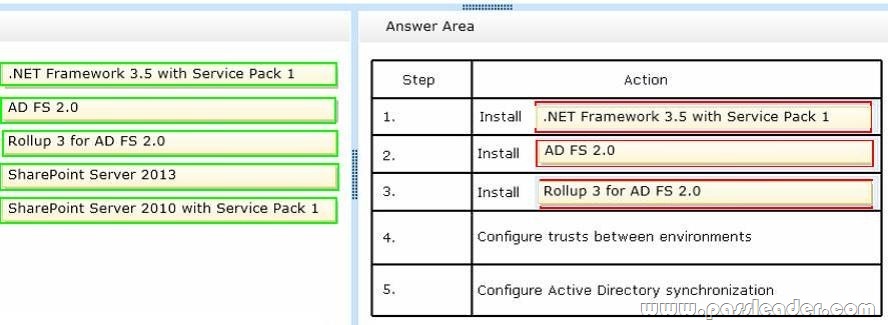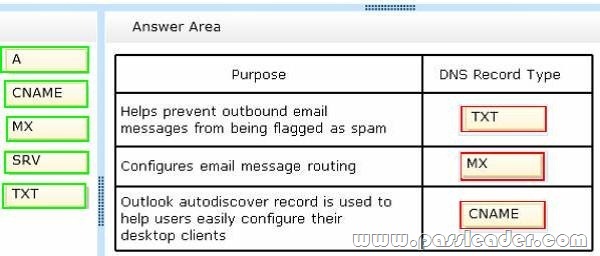Valid 70-346 Dumps shared by PassLeader for Helping Passing 70-346 Exam! PassLeader now offer the newest 70-346 VCE dumps and 70-346 PDF dumps, the PassLeader 70-346 exam questions have been updated and ANSWERS have been corrected, get the newest PassLeader 70-346 dumps with VCE and PDF here: http://www.passleader.com/70-346.html (276 Q&As Dumps –> 317 Q&As Dumps –> 357 Q&As Dumps)
BTW, DOWNLOAD part of PassLeader 70-346 dumps from Cloud Storage: https://drive.google.com/open?id=0B-ob6L_QjGLpfm1La0ItQ21Qdi0xSmcwYTF2cl9CbnNTb2JWeFBJUHA3cWNhaC1VbTI1ZFk
QUESTION 1
An organization deploys an Office 365 tenant. User accounts must be synchronized to Office 365 by using the Windows Azure Active Directory Sync tool. You have the following password policies:
– Passwords for the on-premises Active Directory Domain Services (AD DS) user accounts are at least six characters long.
– Passwords for Office 365 user accounts are at least eight characters long.
You need to ensure that the user accounts will be synchronized. Which user accounts will be synchronized?
A. All user accounts
B. No user accounts
C. User accounts with a password length of at least 8 characters
D. User accounts with a password length of at least 14 characters
Answer: A
Explanation:
After deploying ADFS tenant password policies are handled by the local Active Directory Environment, and not Office 365 Azure. All users will be synchronized and will utilize the AD DS six character long password policy.
http://howdouc.blogspot.ca/2011/04/active-directory-federation-services.html
When you enable password sync, the password complexity policies configured in the on-premises Active Directory override any complexity policies that may be defined in the cloud for synchronized users. This means any password that is valid in the customer’s on-premises Active Directory environment can be used for accessing Azure AD services. As synchronization copies users info from local AD to Azure office 365 AD. 6 characters “local” will be accepted within 8 characters “cloud”. It’s true that After deploying ADFS tenant password policies are handled by the local Active Directory Environment, and not Office 365 Azure, however. This is not the case in this question! It’s not ADFS Also, my understanding that old DirSync doesn’t synchronize passwords from ADDS to Azure AD. only the new Azure Active Directory Sync AADS.
QUESTION 2
Contoso, Ltd. plans to use Office 365 for email services and Lync Online. Contoso has four unique domain names. You need to migrate domain names to Office 365. Which two domain names should you exclude from the migration? Each correct answer presents part of the solution.
A. contoso.us
B. contoso
C. contoso.local
D. contoso.co
Answer: BC
Explanation:
contoso.us – valid TLD Domain
contoso.co – valid TLD Domain
contoso – single labeled domain – not valid
contoso.local – internal labeled domain – not valid
http://technet.microsoft.com/en-us/library/hh852440.aspx
You need to add and verify a domain only once. If someone else in your organization has already added and verified the same domain, you can’t add the domain again. You can add multiple domains to Office 365, but each domain has to have a valid Internet domain suffix, such as .com, .co, .net, .org, or a country code. Here are some examples:
– Supported: contoso.com
– Supported: contoso.us
– Not supported: contoso
– Not supported: contoso.local
QUESTION 3
Hotspot Question
An organization prepares to migrate to Office 365. The organization has one domain controller named NYC-DC1 and one server named NYC-DS that is designated as the directory synchronization computer. The organization has the following servers:

You plan to upgrade the servers to support directory synchronization. You must upgrade each server to meet only the minimum requirements by using the least amount of administrative effort. You need to ensure that you can use the Windows Azure Active Directory Sync tool to synchronize the local Active Directory with Office 365. What should you do? Select the correct action from each list in the answer area.

Answer:
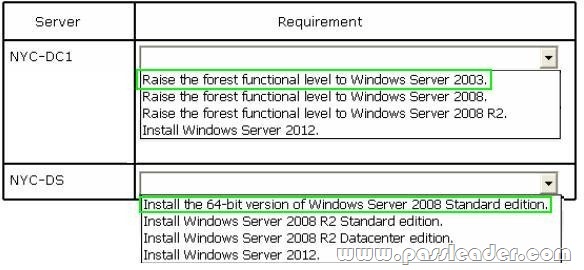
Explanation:
Function level of 2003 is minimum, as the OS for DirSync must be minimum 2008 (no r2).
http://msdn.microsoft.com/en-us/library/azure/jj151831.aspx
QUESTION 4
You are the Office 365 administrator for your company. The company synchronizes the local Active Directory objects with a central identity management system. The environment has the following characteristics:
– Each department has its own organizational unit (OU).
– The company has OU hierarchies for partner user accounts.
– All user accounts are maintained by the identity management system.
You need to ensure that partner accounts are NOT synchronized with Office 365. What should you do?
A. Configure OU-based filtering by using the Windows Azure Active Directory Sync tool.
B. In the Windows Azure Active Directory portal, configure OU-based filtering.
C. Configure user attribute-based filtering by using the Windows Azure Active Directory Sync tool.
D. In the Windows Azure Active Directory portal, configure user attribute-based filtering.
Answer: A
Explanation:
http://technet.microsoft.com/en-us/library/jj710171.aspx
QUESTION 5
Your company subscribes to an Office 365 Plan E3. A user named User1 installs Office Professional Plus for Office 365 on a client computer. From the Microsoft Online Services portal, you assign User1 an Office Professional Plus license. One month after installing Office, User1 can no longer save and edit Office documents on the client computer. User1 can open and view Office documents. You need to ensure that User1 can save and edit documents on the client computer by using office. What should you do?
A. Install the Office Customization Tool.
B. Reinstall Office Professional Plus.
C. Install the Microsoft Online Services Sign-in Assistant.
D. Upgrade the subscription to Plan E4.
Answer: C
Explanation:
http://technet.microsoft.com/en-us/library/gg702619(v=office.15).aspx
QUESTION 6
Your company uses Office 365. You need to identify which users do NOT have a Microsoft Exchange Online license assigned to their user account. Which Windows PowerShell cmdlet should you use?
A. Get-ManagementRoleAssignment
B. Get-User
C. Get-RoleGroupMember
D. Get-LogonStatistics
E. Get-RemovedMailbox
F. Get-MSOLContact
G. Get-Recipient
H. Get-Mailbox
I. Get-Group
J. Get-MailboxStatistics
K. Get-MSOLUser
L. Get-MailContact
Answer: K
QUESTION 7
Your company has an Office 365 subscription. You create a new retention policy that contains several retention tags. A user named Test5 has a client computer that runs Microsoft Office Outlook 2007. You install Microsoft Outlook 2010 on the client computer of Test5. Test5 reports that the new retention tags are unavailable from Outlook 2010. You verify that other users can use the new retention tags. You need to ensure that the new retention tags are available to Test5 from Outlook 2010. What should you do?
A. Instruct Test5 to repair the Outlook profile.
B. Modify the retention policy tags.
C. Run the Set-Mailbox cmdlet.
D. Force directory synchronization.
Answer: A
QUESTION 8
Drag and Drop Question
A company has a Windows Server 2008 domain controller and a SharePoint 2007 farm. All servers on the network run Windows Server 2008. You must provide single sign-on for Office 365 SharePoint sites from the company’s network. You need to install the required software. What should you install? To answer, drag the appropriate action to the correct location. Each answer may be used once, more than once, or not at all. You may need to drag the split bar between panes or scroll to view content.
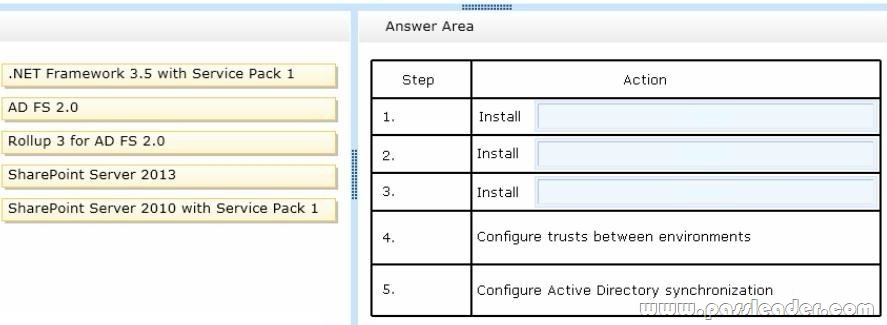
QUESTION 9
You are the Office 365 administrator for your company. The environment must support single sign-on. You need to install the required certificates. Which two certificates should you install? Each correct answer presents part of the solution.
A. Secure Sockets Layer (SSL)
B. Privacy-enhanced mail (PEM)
C. Token signing
D. Personal
E. Software publisher
Answer: AC
QUESTION 10
A company deploys an Office 365 tenant. You need to configure single sign-on (SSO) for all user accounts. Which two actions should you perform? Each correct answer presents part of the solution.
A. Run the Windows PowerShell cmdlet Convert-MsolDomainToStandard.
B. Run the Windows PowerShell cmdlet Enable-ADFSEndpoint.
C. Run the Windows PowerShell cmdlet Convert-MsolDomainToFederated.
D. Deploy a federation server proxy.
E. Run the Windows PowerShell cmdlet New-ADFSOrganization.
F. Deploy a federation server farm.
Answer: CF
Explanation:
http://technet.microsoft.com/en-us/library/dn194092.aspx
QUESTION 11
Hotspot Question
An organization deploys an Office 365 tenant. The Service health page displays the following information:

You need to report the status of service interruptions for Exchange Online and SharePoint Online. Use the drop-down menus to complete each statement based on the information presented in the screen shot. Each correct selection is worth one point.

Answer:

Explanation:
Microsoft will provide the PIR within five business days following resolution of the service incident.
http://technet.microsoft.com/en-us/library/office-365-service-continuity.aspx
QUESTION 12
You are the Office 365 administrator for your company. Users report that they have received significantly more spam messages over the past month than they normally receive. You need to analyze trends for the email messages received over the past 60 days. From the Office 365 admin center, what should you view?
A. The Mail protection reports
B. The Mailbox content search and hold report
C. Messages on the Message center page
D. The Office 365 Malware detections in sent mail report
Answer: A
Explanation:
Use mail protection reports in Office 365 to view data about malware, spam, and rule detections. If you’re an Exchange Online or Exchange Online Protection (EOP) admin, there’s a good chance you’d like to monitor how much spam and malware is being detected, or how often your transport rules are being matched. With the interactive mail protection reports in the Office 365 admin center, you can quickly get a visual report of summary data, and drill- down into details about individual messages, for as far back as 90 days.
https://technet.microsoft.com/en-us/library/dn500744(v=exchg.150).aspx
QUESTION 13
Hotspot Question
The legal department in your organization creates standardized disclaimers for all of their email messages. The disclaimers explain that any transmissions that are received in error should be reported back to the sender. You track any confidential documents that are attached to email messages. Your security team reports that an employee may have mistakenly sent an email message that contained confidential information. You need to identify whether the email message included the disclaimer and whether it contained confidential information. Which two options should you configure? To answer, select the appropriate objects in the answer area.

QUESTION 14
A company deploys an Office 365 tenant in a hybrid configuration with Exchange Server 2013. Office 365 users cannot see free/busy information that is published from the on-premises Exchange Server. In addition, Exchange Server users cannot see free/busy information that is published from Office 365. You need to troubleshoot why users cannot access free/busy information from both Office 365 and Exchange Server 2013. Which tool should you run?
A. The Hybrid Configuration wizard
B. The Remote Connectivity Analyzer with the Exchange Server tab selected
C. The Microsoft Connectivity Analyzer Tool
D. The Remote Connectivity Analyzer with the Office 365 tab selected
Answer: D
QUESTION 15
You are the Office 365 administrator for your company. Users report that they cannot sign in to Lync from their mobile devices, but they are able to send and receive Lync messages by using their laptop computers. You need to troubleshoot the issue. What should you do?
A. From the Office 365 message center, confirm Lync settings.
B. Use the Microsoft Connectivity Analyzer tool to confirm settings.
C. Confirm Lync user licenses for the affected users.
D. From the Lync admin center, verify the external access settings.
Answer: B
QUESTION 16
An organization migrates to Office 365. The Office 365 administrator must be notified when Office 365 maintenance activities are planned. You need to configure the administrator’s computer to receive the notifications. What should you configure?
A. Office 365 Management Pack for System Center Operations Manager
B. Service requests
C. Service health page
D. Office 365 Service Health RSS Notifications feed
Answer: D
Explanation:
http://technet.microsoft.com/en-us/library/office-365-service-health.aspx
QUESTION 17
Your company deploys an Office 365 tenant. You need to ensure that you can view service health and maintenance reports for the past seven days. What are two possible ways to achieve this goal? Each correct answer presents a complete solution.
A. Run the Microsoft Online Services Diagnostics and Logging (MOSDAL) Support Kit.
B. View the service health current status page of the Office 365 admin center.
C. View the service settings page of the Office 365 admin center.
D. Subscribe to the Office 365 Service Health RSS Notifications feed.
Answer: BD
Explanation:
http://community.office365.com/en-us/w/diagnostic_tools/default.aspx
QUESTION 18
Drag and Drop Question
You implement Office 365 for an organization. You must create the correct DNS entries needed to configure Office 365. Which DNS entries should you create? To answer, drag the appropriate DNS record type to the correct purpose. Each DNS record type may be used once, more than once, or not at all. You may need to drag the split bar between panes or scroll to view content.
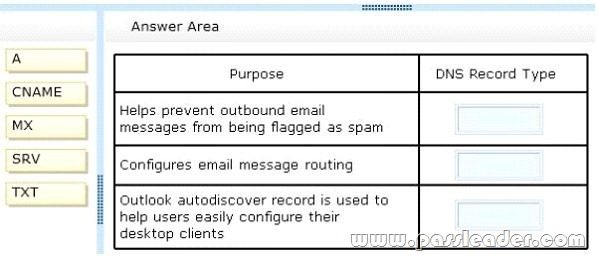
Get the newest PassLeader 70-346 VCE dumps here: http://www.passleader.com/70-346.html (276 Q&As Dumps –> 317 Q&As Dumps –> 357 Q&As Dumps)
And, DOWNLOAD the newest PassLeader 70-346 PDF dumps from Cloud Storage for free: https://drive.google.com/open?id=0B-ob6L_QjGLpfm1La0ItQ21Qdi0xSmcwYTF2cl9CbnNTb2JWeFBJUHA3cWNhaC1VbTI1ZFk
